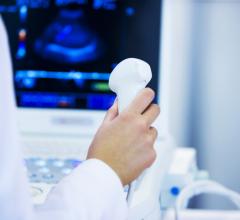
Vivid E95 image courtesy of GE Healthcare
November 16, 2015 — At the Radiological Society of North America (RSNA) 2015 annual meeting, GE Healthcare will unveil the next generation of its Logiq E9 general imaging ultrasound system. The system combines the power of XDclear probes with a new XDclear 2.0 platform that maximizes spatial and contrast resolution. As a result, XDclear 2.0 optimizes the imaging from the pulse of the probe to each of its pixels and every step in between.
GE Healthcare will also showcase a comprehensive portfolio of ultrasound hardware and software solutions for a range of patient care solutions:
Vivid E95/E90 with cSound software: GE’s newest cardiovascular ultrasound systems are developed to help physicians effectively diagnose conditions in patients while potentially reducing additional tests often required in evaluating heart conditions, such as heart failure. cSound is a supercomputer-inspired software that uses algorithms to collect an infinite amount of data and then select pixel-by-pixel the most precise information to generate high-quality images of the heart.
Vscan with Dual Probe: With the first-of-its-kind 2-in-1 probe, the Vscan with Dual Probe offers healthcare providers many uses for pocket ultrasound. This pocket-sized ultrasound device houses two transducers in a single probe, allowing clinicians to see both shallow and deep views of the body without changing probes. This helps enable efficient triage and fast workflow, which may lead to time and cost savings in point-of-care settings. It also may add clinical value in a wide variety of resource-constrained environments with a pocket-sized device that covers many point-of-care ultrasound procedures.
Voluson E10 with HDlive technology: GE's newest and most advanced Voluson system to date features the world's first curved matrix electronic 4-D probe designed specifically for OB/GYN and the next-generation version of its HDlive software. The system offers healthcare providers four times the ultrasound pathways for improved clarity and 2-D and 3-D/4-D images with increased penetration; 10 times the data transfer rates for more speed and to give higher resolution and very fast frame rates; and four times the processing power for more flexibility with advanced applications and efficient workflow.
Invenia ABUS and Volpara: Automated breast ultrasound (ABUS) breast imaging technology has shown a 55 percent relative increase in detecting invasive breast cancers in women with dense breasts over mammography alone. The Invenia ABUS acquisition process uses 3-D ultrasound technology to comfortably and quickly image women with dense breast tissue in approximately 15 minutes with features that conform to a woman's anatomy, which helps provide patient comfort. Volpara Solutions’ suite of quantitative breast imaging tools enable personalized measurements of volumetric density, patient-specific dose, breast compression and other factors designed to provide critical insight for breast imaging quality and workflow. Together with Volpara’s technology, GE Healthcare’s comprehensive breast care solution can further enable clinicians to detect early stage breast cancers and help improve the patient experience.
For more information: www.gehealthcare.com


 May 29, 2024
May 29, 2024 








